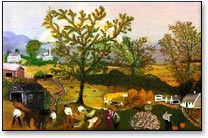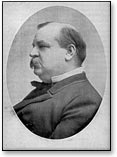In those earlier days, butter making was largely the province of the farm wife. A "cool hand" was the term used for giftedness in butter‑making: kneading butter required swift, firm movements and a low temperature. When a farmer from an English county like Cheshire, famous for its dairy produce, sought a wife, he chose brawn over delicacy every time. In one village it was traditional for a young girl to lift the immensely heavy lid of the parish chest with one hand, to show how desirable she was.
She first skimmed the cream from the surface milk allowed to "set" in shallow bowls or pails. The cream was then usually churned in the old familiar wooden cooper-made dash churn invariably referred to as an instrument of torture by those who, as boys, had to operate them. Other forms of churns were introduced from time to time, such as rocker churns, swing churns, circular churns with revolving paddles and square box churns swung by diagonal corners -- none of them, however, becoming sufficiently popular to displace the dash churn until the barrel churn was later developed for factory use.
These farm wives of earlier days often used their butter as barter at the general stores in small country towns or trading centers in exchange for merchandise needed at home. The more enterprising storekeepers would encourage those ladies whose products they recognized as being of superior quality, to use different types, and incidentally ever-increasing sizes, of containers as packages for their product. Wooden pails holding five or ten pounds were used as well as earthenware crocks. Bradley butter boxes of circular construction with wooden slip covers and made of spruce or maple-veneer were popular in New England and New York State in the 1880's. Also, tapered spruce tubs were used to some extent on farms. Wooden containers thus came into general use, as other materials were not generally available such as paperboard, for example. Woodworking was extensive in those earlier days and as a matter of fact, the first utensils used on farms making butter were mostly made of wood.
While some store proprietors encouraged farm wives to pack their product in tubs, Bradley boxes and the like, most of the farm butter brought into the general store was in the form of "pats" or "rolls." As a matter of fact, butter "rolls" became known as cash-weight rolls. As more and more farm butter was produced, local markets could not consume it all locally and therefore it was shipped to ladlers and renovating plants located in central points. The best butter was sorted out and reworked, packed and sent to the market under various trade names. The poorer grades were sent to renovating plants where the butter was melted, and the butterfat was mixed with skim milk and reworked. The renovating plant was placed under Federal supervision and required a special license. Adulteration of butter became a menace and to further confuse the public, colored oleomargarine was offered for sale as butter.


